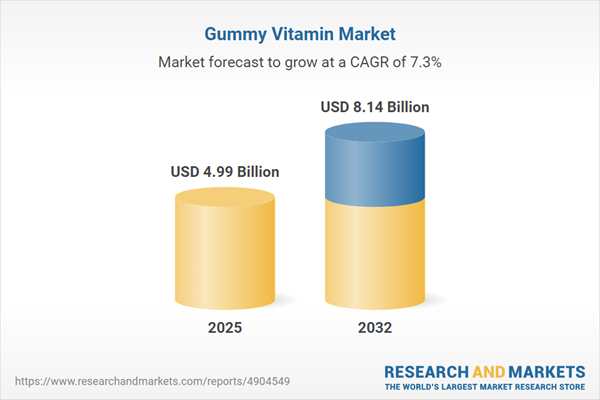Speak directly to the analyst to clarify any post sales queries you may have.
The gummy vitamin market is evolving rapidly, propelled by shifting consumer preferences, innovation in supplement delivery forms, and a dynamic global regulatory landscape. Senior decision-makers require actionable insights to navigate this competitive sector and identify opportunities for growth and operational resilience.
Gummy Vitamin Market Snapshot
The global gummy vitamin market grew from USD 4.64 billion in 2024 to USD 4.99 billion in 2025 and is projected to reach USD 8.14 billion by 2032, reflecting a CAGR of 7.26%.
This trajectory demonstrates robust market confidence, driven by demand for convenient and palatable nutritional supplements across multiple demographics. Manufacturers and retailers are responding with new product launches, expanded online distribution, and strategic collaborations that leverage both digital and traditional sales channels.Scope & Segmentation
- Product Types: Herbal extracts, mineral blends, multi vitamin formulations, probiotics, and single vitamins (such as Vitamin B Complex, Vitamin C, and Vitamin D) address diverse consumer wellness needs.
- Sales Channels: Key points of sale include convenience stores, brand websites, third-party e-commerce platforms, pharmacy and drug stores (chain and independent), specialty stores, as well as supermarkets and hypermarkets.
- Consumer Age Groups: Offerings are tailored to adults, children (with distinct options for teenagers, toddlers, and youth), prenatal consumers, and seniors (including subcategories for baby boomers and the silent generation).
- Ingredient Sources: Companies offer both natural options (fruit-based and plant-based) and synthetic, lab-synthesized formulations.
- Regions Covered: The report analyzes market activity in the Americas (North and Latin America), Europe, Middle East & Africa, and Asia-Pacific, with attention to localized regulations, consumption habits, and infrastructure considerations.
- Featured Companies: Profiled organizations include Church & Dwight Co., Inc., Bayer AG, Pfizer Inc., Reckitt Benckiser Group plc, The Bountiful Company LLC, Olly Public Benefit Corporation, Goli Nutrition, Inc., Swisse Wellness Pty Ltd, Hero AG, and SmartyPants Vitamins, LLC.
Key Takeaways for Senior Decision-Makers
- Consumer demand is shifting toward clean label, personalized nutrition solutions, particularly among discerning segments seeking transparency in ingredient sourcing.
- Digital-first business models, such as direct-to-consumer sales and subscription-based platforms, are disrupting traditional retail channels and offering new routes for consumer engagement.
- Strategic partnerships between manufacturers, biotechnology firms, and retailers are accelerating time-to-market for targeted nutritional formulations and expanding market access.
- Supply chain resilience has become a top priority as stakeholders adapt to regulatory changes and optimize inventory strategies in response to evolving trade policies.
- Brand differentiation relies increasingly on sustainability initiatives, including recyclable packaging and clear sourcing information, reflecting heightened environmental awareness among buyers.
- Comprehensive segmentation by product type, age group, and ingredient source allows precise targeting, supporting development of high-value, demographically tailored offerings.
Tariff Impact on Supply Chains
In 2025, new United States tariffs affected the cost structures for gummy vitamin imports, specifically targeting gelatin derivatives, fruit extracts, and botanical ingredients. Companies responded by reassessing procurement sources and strengthening cross-functional teams to ensure compliance and continued supply chain visibility. Diversification of ingredient sourcing and adjustments in inventory management were key to maintaining operational agility and protecting margins.
Methodology & Data Sources
This analysis leverages a multi-stage methodology, including secondary research from regulatory databases, industry publications, and trade association reports, supported by primary interviews with industry executives and supply chain specialists. Analytical frameworks such as SWOT and Porter’s Five Forces were applied to validate findings and eliminate bias.
Why This Report Matters
- Enables strategic planning by providing in-depth segmentation and regulatory analysis for the gummy vitamin market.
- Supports operational resilience by detailing supply chain, procurement, and compliance best practices in volatile policy environments.
- Empowers leaders to identify untapped growth opportunities in emerging regions and nascent consumer segments.
Conclusion
This report equips decision-makers with the insight needed to foster growth and navigate ongoing challenges within the evolving gummy vitamin sector. Readers can rely on these findings to inform action and create lasting value in a competitive marketplace.
Additional Product Information:
- Purchase of this report includes 1 year online access with quarterly updates.
- This report can be updated on request. Please contact our Customer Experience team using the Ask a Question widget on our website.
Table of Contents
3. Executive Summary
4. Market Overview
7. Cumulative Impact of Artificial Intelligence 2025
Companies Mentioned
The companies profiled in this Gummy Vitamin market report include:- Church & Dwight Co., Inc.
- Bayer AG
- Pfizer Inc.
- Reckitt Benckiser Group PLC
- The Bountiful Company LLC
- Olly Public Benefit Corporation
- Goli Nutrition, Inc.
- Swisse Wellness Pty Ltd
- Hero AG
- SmartyPants Vitamins, LLC
Table Information
| Report Attribute | Details |
|---|---|
| No. of Pages | 196 |
| Published | November 2025 |
| Forecast Period | 2025 - 2032 |
| Estimated Market Value ( USD | $ 4.99 Billion |
| Forecasted Market Value ( USD | $ 8.14 Billion |
| Compound Annual Growth Rate | 7.2% |
| Regions Covered | Global |
| No. of Companies Mentioned | 11 |









